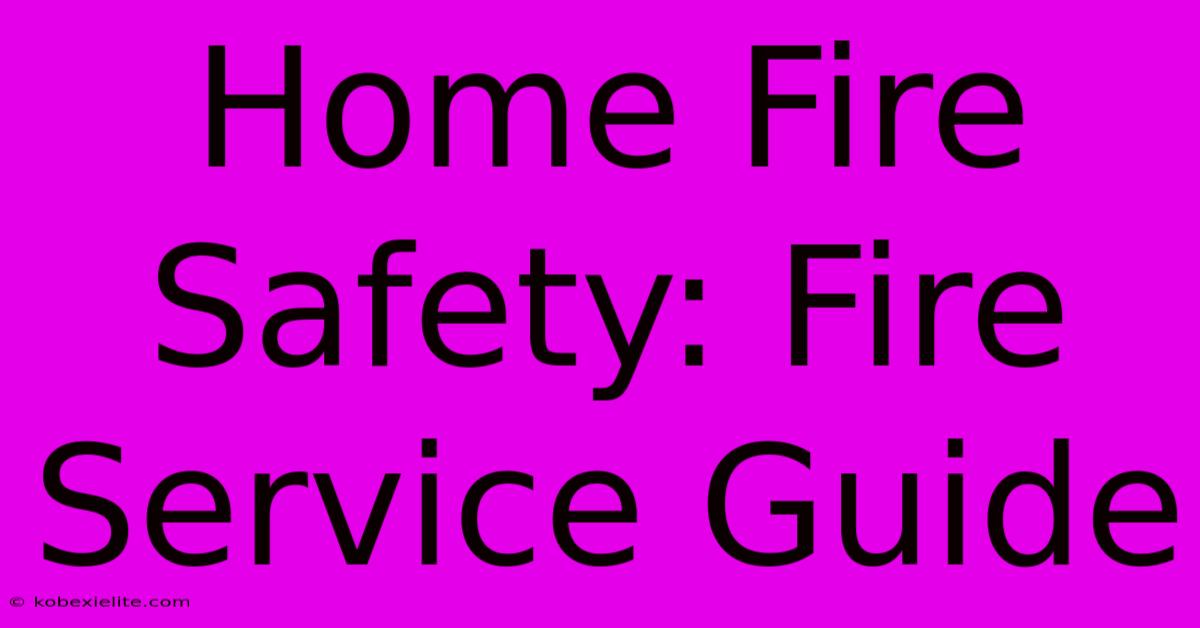Home Fire Safety: Fire Service Guide

Discover more detailed and exciting information on our website. Click the link below to start your adventure: Visit Best Website mr.cleine.com. Don't miss out!
Table of Contents
Home Fire Safety: A Fire Service Guide
Home fires are a devastating reality, claiming lives and destroying property every year. But with proactive measures and a solid understanding of fire safety, you can significantly reduce your risk. This comprehensive guide, developed with input from fire service professionals, provides essential information and actionable steps to protect your home and family.
Understanding Fire Risks in Your Home
Before we delve into prevention and response, let's identify common fire hazards in the home. Understanding these risks is the first step to mitigating them.
Common Fire Hazards:
- Cooking: Unattended cooking is the leading cause of home fires. Always stay in the kitchen when cooking, and never leave cooking unattended, even for a short time.
- Heating Equipment: Faulty or improperly used heating equipment, including space heaters, fireplaces, and furnaces, poses a significant risk. Regular maintenance and proper ventilation are crucial.
- Electrical Issues: Overloaded circuits, frayed wires, and damaged appliances can spark fires. Regular electrical inspections and the avoidance of overloaded outlets are essential.
- Smoking Materials: Cigarettes, cigars, and pipes are leading causes of fatal fires. Always extinguish smoking materials completely and use ashtrays with water or sand.
- Candles: Never leave burning candles unattended. Keep them away from flammable materials, and always extinguish them before leaving a room or going to sleep.
Preventing Home Fires: A Proactive Approach
Prevention is always better than cure. These proactive steps significantly reduce your risk of a home fire:
Essential Safety Measures:
- Install Smoke Alarms: Install smoke alarms on every level of your home, inside bedrooms, and outside sleeping areas. Test them monthly and replace batteries annually. Consider interconnected smoke alarms that alert all units simultaneously. This is paramount!
- Develop and Practice an Escape Plan: Create a home fire escape plan, identifying two ways to exit each room. Practice the plan with your family regularly, especially with children. Establish a meeting place outside the home.
- Regular Maintenance: Schedule regular maintenance for heating and cooling systems, chimneys, and electrical wiring. Address any issues immediately.
- Safe Cooking Practices: Always supervise cooking, keep flammable materials away from the stovetop, and use caution when handling hot oil or grease.
- Proper Storage of Flammable Materials: Store flammable liquids, such as gasoline and cleaning solvents, in designated safety containers and away from ignition sources.
Responding to a Home Fire: Emergency Procedures
If a fire does occur, knowing how to respond quickly and safely can save lives.
Emergency Action Steps:
- Get Out, Stay Out: Once you detect a fire, immediately evacuate the premises. Do not attempt to fight the fire yourself unless it's a very small, contained fire.
- Call 911: Call emergency services from a safe location once you are outside. Provide your address and a description of the situation.
- Once Outside: Do a headcount to ensure everyone is out of the house.
- Never Go Back Inside: Resist the urge to retrieve belongings. Your life is more valuable than material possessions.
Beyond the Basics: Additional Safety Tips
- Childproofing: Install childproof smoke alarm covers and keep matches and lighters out of reach of children.
- Space Heater Safety: Never leave space heaters unattended and keep them away from flammable materials.
- Fire Extinguishers: Consider purchasing and learning how to use a fire extinguisher. Know the different classes of fires and the appropriate extinguisher type. However, remember that evacuation is the primary response.
- Regular Inspections: Conduct regular home safety inspections to identify potential hazards.
This guide provides crucial information, but it's not a substitute for professional fire safety training. Consider attending a fire safety course in your community for in-depth knowledge and hands-on experience.
By following these guidelines and maintaining a vigilant approach to fire safety, you can create a safer and more secure environment for your family and yourself. Remember, preparedness is key to preventing and responding to home fires effectively.

Thank you for visiting our website wich cover about Home Fire Safety: Fire Service Guide. We hope the information provided has been useful to you. Feel free to contact us if you have any questions or need further assistance. See you next time and dont miss to bookmark.
Featured Posts
-
Australia Visit Amid Rising Tensions
Feb 15, 2025
-
Issa Rae Exits Trump Event Drama
Feb 15, 2025
-
Pop Rock Duo Air Supply Aussie Tour
Feb 15, 2025
-
Twenty Run Win Boosts Black Caps
Feb 15, 2025
-
Kff Medicaid Expansion Rate Reduction
Feb 15, 2025
